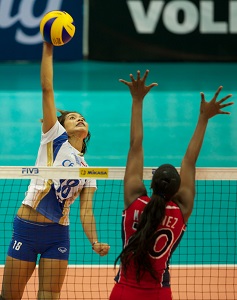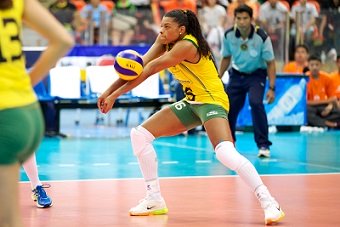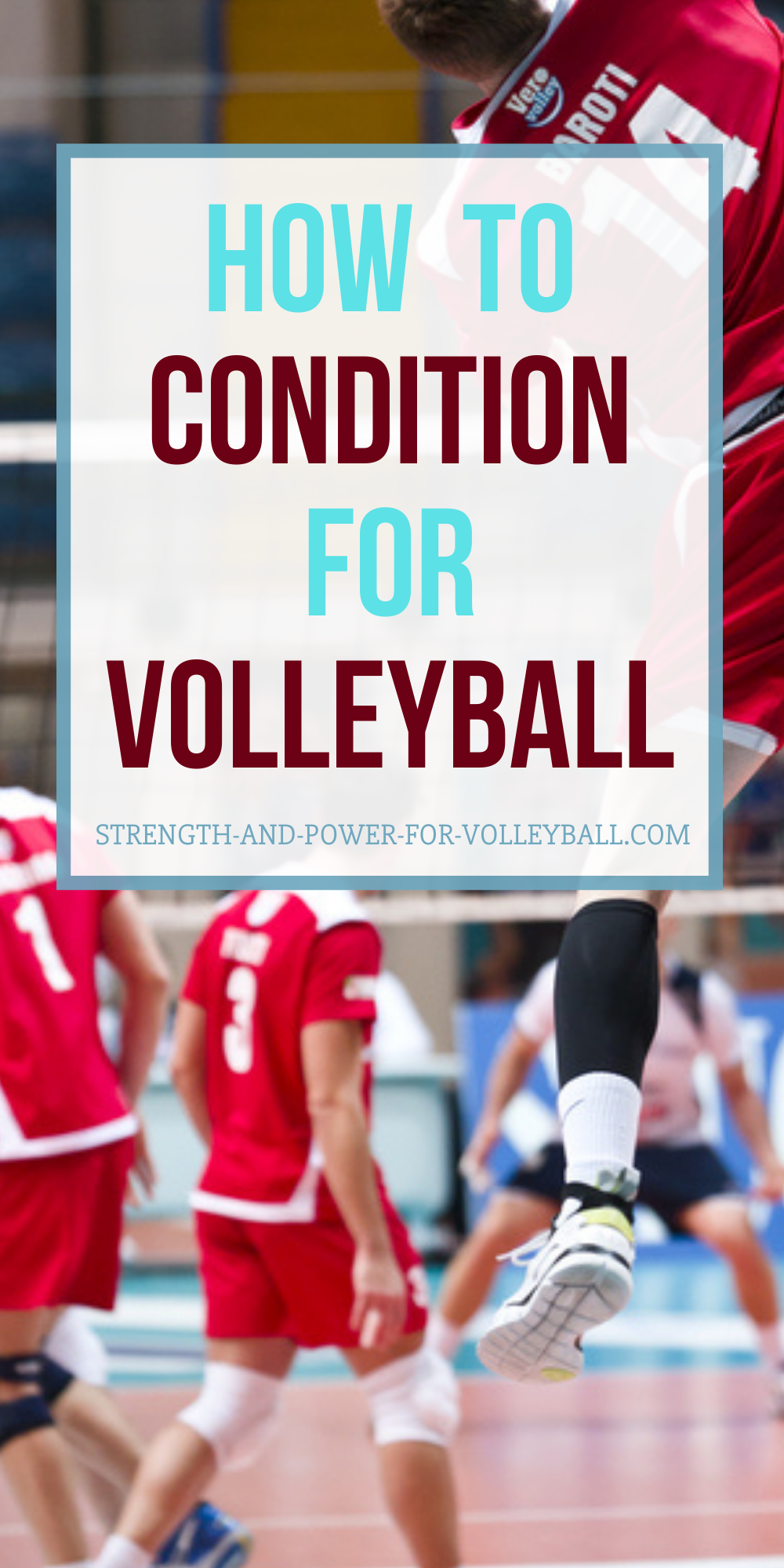- Home
- Conditioning
- Volleyball Game Conditioning
Successfully Train Right for Volleyball
Game Like Conditioning
Volleyball game like conditioning drills to improve super fast. Not all conditioning is created equal. It's important to learn the best way to develop endurance, strength, and speed for volleyball.
Conditioning that's Volleyball Game Like
Things to consider...
-
Energy systems. The way your body uses energy is defined into 3 systems...
1)phosphagen, 2)glycolytic, and 3)oxidative.
Not all athletes rely on the same energy systems. The more your sport involves fast explosive movements, the more you'll need the phosophagen system. The more your sport requires low power over longer durations, the more you'll need the oxidative system.
Most sports involve a combination of all three energy systems.
The two primary anaerobic energy systems used in volleyball are the phosphagen and glycolytic. -
Work to rest ratio. In a volleyball game, the average rally is 4 to 6 seconds. The average time between rallies is 11 to 16 seconds.
So work:rest is about 1:3 or 1:4.
This is important to know because in order to train the right energy systems, work:rest during training should be similar to the work:rest during performance. -
Strength/power/endurance. A volleyball game is a sport that involves high
explosive effort with some time for rest between explosive efforts.
REST is a critical and often overlooked variable when it comes to improving strength and power. Rest is critical because without adequate recovery time, your phosophagen system won't adequately recover for the next bout of explosive effort.
Have you conditioned right to spike?
Energy Systems in a Volleyball Game
The primary energy systems used vary from sport to sport.
The main point here is to be sure you're challenging the right energy systems for a volleyball game.
Specificity: ...our body reacts specifically to the stimulus we present to it.
There are basically 3 types of energy systems...
1)phosphagen
2)glycolytic
3)oxidative.
Strength athletes are kings of the phosphagen energy system.
Volleyball involves strong explosive movements. You need to be fast to
get in position to make plays on defense. To jump high and hit hard, you
need to
be strong and explosive.
Since athletic movements in volleyball require maximum effort, the phosphagen
system is important for volleyball players.
| Metabolic Demands for Various Sports | |||
|---|---|---|---|
| Sport | Phosphagen System | Anaerobic Glycolysis | Aerobic Metabolism |
| Baseball | High | ――― | ――― |
| Basketball | High | Moderate to High | Moderate to High |
| Boxing | High | High | High |
| Football | High | Moderate | Moderate |
| Gynastics | High | Moderate | Moderate |
| Golf | High | ――― | ――― |
| Ice Hockey | High | Moderate | Moderate |
| Soccer | High | Moderate | High |
| Tennis | High | ――― | ――― |
| Volleyball | High | Moderate | ――― |
| Wrestling | High | High | Moderate |
Training the Phosphagen and Glycolytic Systems for Volleyball
The Phosophagen System
It takes just thousandths of a second for the phosphagen system to kick in.
The phosphagen system is a short duration system. It works for about the first six seconds at full power before completely
depleting out by 30 seconds.
It relies on ATP (adenosine tri-phosphate) and CP (creatine phosphate) for fuel rather than oxygen.
Phosphagen can moderately fuel up in 30-60 seconds, but you usually need 3-5 minutes to get back to full capacity.
What energy is your training focused on?
The Glycolytic System
The glycolytic system starts kicking in at around 15 seconds. This system is
running on all cylinders by 30 seconds, and then starts to drop off significantly after about
a minute.
Glucose is used as a fuel source. Sports drinks such as Gatorade
and Powerade provide energy to help fuel this system. The body pulls
this fuel directly from the blood and also from the stored glycogen in
muscles.
When operating anaerobically, the glycolytic system lasts less than two minutes.
The result is often a burning feeling in your muscles. This burning feeling is
the result of your body producing lactate.
Source of fuel your body needs for volleyball
| Effect of Event Duration on Primary Energy System | |||
|---|---|---|---|
| Duration of Event | Intensity of Event | Primary Energy System(s) | 0-6 seconds | very intense | Phosphagen |
| 6-30 seconds | intense | Phosphagen and fast glycolysis | 30 seconds-2 minutes | heavy | Fast glycolysis |
| 2-3 minutes | moderate | Fast glycolysis and oxidative system | >3 minutes | light | Oxidative system |
To increase quickness, vertical jump, and spiking power... focus on training the phosphagen energy system.
The phosphagen system is the system that powers maximum strength. This is the energy system that needs to be trained to improve strength and explosive power for volleyball.
Are you training to be explosive?
Often you may not feel you're working that hard when using the phosphagen
system.
Working the phosphagen system doesn't produce the same kind of fatigue as the
glycolytic system.
For example, a 1 rep max attempt at the back squat doesn't
produce the same muscle burn that a set of 10 reps at 80% max does.
The glycolytic system is the king of conditioning, but you don't want to make
the mistake of spending too much time training the glycolytic system.
Focusing on the glycolytic system will cause the body to become proficient at that system.
This usually negatively affects the performance of the phosphagen system.
So how do we train?
Play in volleyball isn't continuous. On average, rallies last 4 to 6
seconds with 11 to
16 seconds between each rally. The breaks between rallies are good
because this rest time allows your body to replenish the phosophagen
system.
It's also important to note that the rest breaks aren't long enough to replenish
the phosophagen system completely. This
means the glycolytic system does need to kick in.
Bottom line: Both the phosphagen and glycolytic systems are used while playing volleyball.
A properly designed
volleyball conditioning program works these energy systems.
Work to Rest Ratio
Guidelines for working the phosphagen system...
-
Hard effort should generally last 5-15 seconds.
Rarely lasting more than 15 seconds... and never more than 30 seconds. When in doubt, use a shorter work period. - Each of these work periods should be followed by 30-60 seconds of easy activity or passive rest. An example of this would be something an athlete could easily do continuously for 30 minutes or more.
- Multiple rounds of the above work and rest periods should be performed 5-15 times (or more, if necessary).
- You shouldn't be doubled over, nauseated, or puking during/after these workouts. During the work you should stay fairly strong, not fatigued.
In Summary
Work hard for 5-15 seconds, shorter is often better.
Perform easy rest (active or passive) for 30-60 seconds.
Repeat 5-15+ times.
Volleyball Game-like Conditioning
Most volleyball teams don't have the luxury of working with strength coaches.
Often when a team conditions for volleyball, conditioning is a part of team practice.
The following are tips to improve conditioning at volleyball practice.
Conditioning within Drills
To train the phosphagen system, focus on interval training.
Interval training is training in which an athlete alternates between two work intervals.
In conditioning, the activities require different
degrees of effort.
The 1)intensity and 2)duration of the work intervals and length of 3)rest periods dictates the training response.
WORK:REST
In volleyball, most play is 1:3 or 1:4.
To condition specific to volleyball, create drills that fall into these work:rest ratios.
The following are examples of conditioning drills designed specifically to hit these ranges.
- Continuous Block Jumps. Players jump to block in 15 to 30 second intervals. 1 to 2 minutes of rest between.
- Continuous Defensive touches. For this drill, only have one player on the court. The coach continuously tosses balls over the net. The goal is for the player to pass every ball (or at least get a touch). The coach tosses the ball in a way that makes the player move quickly to cover the court. Set a goal for how many continuous touches. Start with a set time of 15 seconds. 1 minute rest between. Work up to 30 second intervals, 2 minutes rest.
Creating Efficient Practices
From a coaching perspective, time is a big issue.
Coaches soon realize one of the biggest goals for a coach is creating the most efficient practice possible.
A typical practice may be broken down into something like this...
- Warm up. 10 minutes.
- Skills/Movement Patterns. 20 minutes.
- Speed/agility/plyometrics. 20 minutes. (be volleyball game like for a more specific training affect)
- Skills within Drills. 20 minutes.
- Scrimmage/volleyball games. 20 minutes.
Do You Practice Volleyball Game Like?
Important Tips
Condition every practice. Especially if you only practice 3 times a week, don't leave out conditioning.
If you don't use it, you'll lose it.
It's a good idea to condition your team every chance you get. Teams that are in better shape have better practices.
Don't sacrifice technique for fatigue. Poorly conditioned players practice tired. Fatigue in practice leads to bad technique in practice.
If your players aren't in shape to practice, they will often sacrifice technique to make the play.
Often when a team is playing out of shape, the team loses focus and play
becomes sloppy. Conditioning is what
keeps a team playing strong throughout practices and tournaments. Often
the team that outlasts everyone else is the team that's in better
shape.
Condition right. No long distance running. Condition for
volleyball the right way. Focus on interval training and working the
phosphagen and glycolytic energy systems.
Attitude is important. You need to have the right attitude about conditioning for volleyball.
Conditioning often gets a bad wrap because coaches often used conditioning as a consequence poor performance.
Conditioning should be fun and not used as a consequence for making errors in practice.
If you enjoyed these tips and would like to keep it close to you at any time, just save this pin to your Pinterest Volleyball Training Board.


